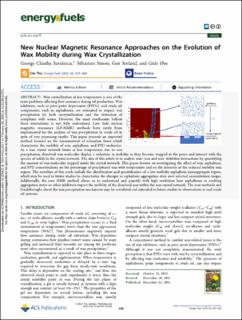| dc.contributor.author | Savulescu, George Claudiu | |
| dc.contributor.author | Simon, Sebastien Charles | |
| dc.contributor.author | Sørland, Geir | |
| dc.contributor.author | Øye, Gisle | |
| dc.date.accessioned | 2023-02-22T14:10:13Z | |
| dc.date.available | 2023-02-22T14:10:13Z | |
| dc.date.created | 2022-01-14T14:54:04Z | |
| dc.date.issued | 2021 | |
| dc.identifier.citation | Energy & Fuels. 2021, 36 (1), 350-360. | en_US |
| dc.identifier.issn | 0887-0624 | |
| dc.identifier.uri | https://hdl.handle.net/11250/3053373 | |
| dc.description.abstract | Wax crystallization at low temperature is one of the main problems affecting flow assurance during oil production. Wax inhibitors, such as pour point depressants (PPDs), and crude oil components, such as asphaltenes, are estimated to impact wax precipitation by both cocrystallization and the formation of complexes with waxes. However, the exact mechanism behind these interactions is not fully understood. Low field nuclear magnetic resonance (LF-NMR) methods have rarely been implemented for the analysis of wax precipitation in crude oil in spite of very promising results. This paper presents an improved method focused on the measurement of relaxation times which characterize the mobility of wax, asphaltene, and PPD molecules. As a wax crystal network forms at low temperature due to wax precipitation, dissolved wax molecules display a reduction in mobility as they become trapped in the pores and interact with the species of solids in the crystal network. The aim of this article is to analyze wax–wax and wax–inhibitor interactions by quantifying the amount of wax molecules trapped inside the crystal network. This paper focuses on investigating the effect of wax, asphaltene, and PPD concentrations on the percentage of precipitated wax with temperature and on the intensity of the reduced mobility wax region. The novelties of this work include the identification and quantification of a low mobility asphaltene nanoaggregate region, which may be used in future studies to characterize the changes in asphaltene aggregation state over selected concentration ranges. Additionally, the new NMR method allows us to understand and quantify with high resolution how asphaltenes in evolving aggregation states or other inhibitors impact the mobility of the dissolved wax within the wax crystal network. The new methods and breakthroughs about the wax precipitation mechanism may be correlated and extended in future studies to observations in real crude oil systems. | en_US |
| dc.language.iso | eng | en_US |
| dc.publisher | American Chemical Society | en_US |
| dc.rights | Navngivelse 4.0 Internasjonal | * |
| dc.rights.uri | http://creativecommons.org/licenses/by/4.0/deed.no | * |
| dc.title | New Nuclear Magnetic Resonance Approaches on the Evolution of Wax Mobility during Wax Crystallization | en_US |
| dc.title.alternative | New Nuclear Magnetic Resonance Approaches on the Evolution of Wax Mobility during Wax Crystallization | en_US |
| dc.type | Peer reviewed | en_US |
| dc.type | Journal article | en_US |
| dc.description.version | publishedVersion | en_US |
| dc.source.pagenumber | 350-360 | en_US |
| dc.source.volume | 36 | en_US |
| dc.source.journal | Energy & Fuels | en_US |
| dc.source.issue | 1 | en_US |
| dc.identifier.doi | 10.1021/acs.energyfuels.1c03613 | |
| dc.identifier.cristin | 1981369 | |
| dc.relation.project | Norges forskningsråd: 237893 | en_US |
| cristin.ispublished | true | |
| cristin.fulltext | original | |
| cristin.qualitycode | 2 | |

